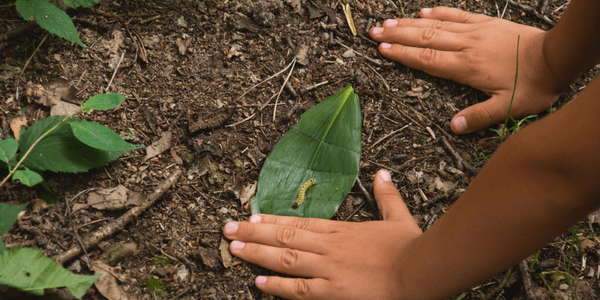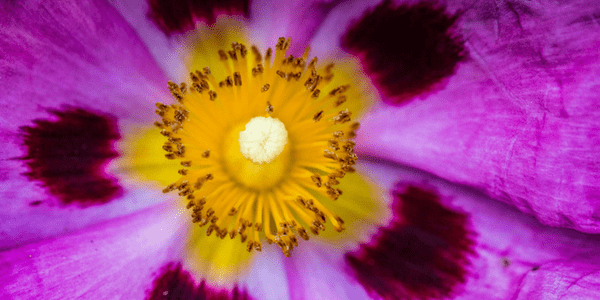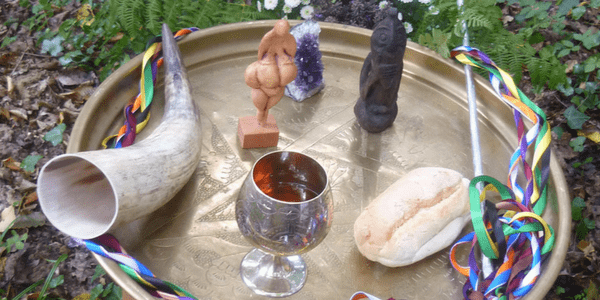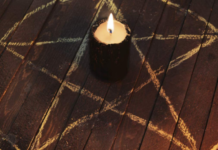The summer solstice has just passed, or the winter solstice, for those in the southern hemisphere. Like so many others, and perhaps even like you yourself, I have marvelled at how fast this year seems to be speeding by. New Year and Imbolc seem far away and at the same time, as though they happened yesterday. Time takes on a weird, almost dreamlike quality, and it seems almost impossible that we are already half way through the year.
The Wheel of the Year is ever turning and sometimes, or rather, quite often, it is easy to miss or take for granted the fact that time is passing. In this way, perhaps we miss some of the magick as well. We put so much effort, time, and planning into the sabbats and the celebrations that go with them, and then we pack it all away after the day and carry on carrying on until the next. Of course, we all lead incredibly busy lives — school, work, family pressures, chores, and all of that, so it’s no surprise that we may not have the time or energy to take stock everyday.
However, if we can try weekly or perhaps even daily celebrations, we can add so much more to our own personal witchcraft and Pagan practices and, as you will see, these needn’t take too much time, but they will require effort.
Related: Natural magick: Remembering our connection to the world, by Chrysanthemum White Alder
Related: 5 ways to connect with nature as an urban Pagan, by Samantha Bell
The sabbats as seasons
One of the ways in which we can begin celebrating the Wheel every day is by changing our perceptions, so instead of viewing the sabbats as individual days and celebrations, we can instead view them as seasons. By seeing the sabbats as seasons, we begin to identify the events that occur in relation to where we live throughout the season, incorporating these changes into our practices, or even just becoming more aware of the world in which we live.
So, what exactly do I mean by season? If we take Samhain as a starting point, then you might view the season starting on this sabbat day. In this instance, the season of Samhain would begin on the 31st of October in the northern hemisphere. This would signify the beginning of the darker months, and last right through up until the day before Yule. Or perhaps you might feel that the sabbat day is the high point of the season, and the weeks leading up to and following it are times of preparation and reflection. However you wish to view the seasons is perfectly fine, and in fact I would encourage all seekers to incorporate their own personal thoughts, feelings, and ideas into building their practice.
By viewing the sabbats as seasons we can appreciate more fully what the season might mean on a more practical and everyday level. It also allows us to notice the smaller events that occur, those that we might otherwise miss. Again using Samhain as an example, we might feel that the season is done with after the day, but the reality is so much more. From Samhain, death is only beginning. Things continue to die back, and creatures that hibernate prepare for their long sleep. The weeks after Samhain are still busy, as nature begins to prepare for the dead months of winter; however, we can sometimes miss this, in part due to the commercialization of our holidays (yes, even us Pagans and witches can still get suckered in). Just like the more mainstream holidays of Hallowe’en, before that’s even over, the shops are full of Christmas stuff, likewise the same is true for Samhain and Yule.
By thinking of the sabbats as seasons, we focus on the present, the here and now, and can fully enjoy each day within that season and recognize the passage of time, not just as months on a calendar, but as the natural cycle that it is.
Related: Hallowe’en: From community celebration to sabbath of evil, by Donyae Coles
Related: Books to read for Hallowe’en
Related: The gift of magick: A holiday guide for skeptics, by Chrysanthemum White Alder

Connection to Land
Viewing the sabbats as seasons leads, naturally, to a connection to the land where you live. Connection to the land is so very important in magick. In my own personal practice, I work with my genius loci, the spirits of place, including plant and tree spirits, and this kind of relationship is forged by connecting to the land where I live.
It doesn’t matter where you live — be it city, town, or country — there will be nature (she abhors a vacuum), and even the business of places such as cities and the vast amount of human activity within such places, will leave their own residues, produce their own cycles and rhythms that can also be worked with.
Wherever you live, it is important to take the time to get to know your surrounding area. Again, it might be hard to fit in time to go outside. If you can walk to work or school, then do so. Take your morning tea or coffee outside. If mobility is an issue, or perhaps you don’t have an outdoor space you feel comfortable using, then open your window and feel the fresh air upon your skin, or the heat of the sun — there is no right or wrong way to do this, so long as the effort is made to do it. When you do this regularly, you’ll begin to notice little details that you missed previously. You might begin to see the same blackbird every morning in the garden as it goes about it’s business, calls for a mate, builds its nest, or look out for its fledgling chick. Or the tree that blossoms, fruits, then dies back — whatever it is, these small changes that happen within your environment will ultimately deepen your connection to the land.
If we take into account the seasons too, then connection to land will enable you to fully appreciate the sabbat more deeply. Within Paganism, we tend to go with the commonly accepted lore. So, for example, Beltane is very much associated with hawthorn, which is all well and good, but what if there are no hawthorn trees where you live, or where you can get to? Such associations may seem hollow, and this is where your connection to and knowledge of the land becomes important. You’ll be able to identify other species of plants and trees that are active or prominent in your locale. Building a practice that utilizes your local knowledge will lead to a more full and meaningful understanding of the Wheel of the Year.
It is also through this connection to land that you will begin to forge your own relationship with the spirits of place, your genius loci. This is important in connection to the Wheel of the Year, because not only will your connection to the land be a physical, but also spiritual. As you grow more confident, as the bond between you and the spirits of place strengthens, you will experience the Wheel of the Year in a more profound way.
As already mentioned, the Wheel is ever turning and so you will perceive this through your work with your genius loci.
Practical exercises
I offer these exercises here in the hope that they will aid you, fellow seeker, in finding a deeper connection to the sabbats, viewing them not as standalone days, but instead as a cycle of changes that occur. The first and perhaps most important practical exercise is to make time for yourself. In doing so, not only will you benefit, but those around you including family members and colleagues will benefit, as you will be more relaxed and content within yourself.
Besides initially making the time to take notice of the subtle events that occur in each season or sabbat, there are other practical exercises that will help you to celebrate and incorporate the sabbats into your everyday life.
Related: Summer activities for magical children, by Donyae Coles
Meditation
Meditations are a useful tool to help explore the sabbats and what they may mean to you in relation to the land where you live. Now, meditations need not be long, drawn out affairs. I think sometimes meditations can be off-putting, because people think they need half an hour or longer spare. This is untrue. You can meditate for five or 10 minutes, and still have a profound experience.
If you are new to meditating, or have struggled in the past, set a meditation goal that is less daunting, as it will also helps to keep you calm. I know that when I first started, I would get so frustrated with myself because I thought I would have to sit there, trying to silence my mind for half an hour! And as you progress and begin to master meditation, you will find yourself meditating for longer periods.
Guided meditation
Write your own guided meditation. It needn’t be anything special, and if you’ve never written your own, then you can find an already existing one and change it to fit your specific needs. I cannot express how much your own guided meditations will impact on your connection to the Wheel of the Year and the incremental changes that occur throughout.
Write one for each of the eight sabbats, incorporating things that mean something to you. As you progress, you can always change them so that they are ever evolving, including new things you have learned or observed.

Make friends with local flora and fauna
Learn about the trees, plants and fauna where you live. Get yourself a good pocket identification guide and familiarize yourself with what grows where. Learn of the folklore about the plants, trees, and animals, and in a journal, make notes about those that particularly inspire you.
Related: Why you should keep a magical journal, by Michael Reese
Forage
I love foraging! Not only is it a great way to work with the seasonal food that nature gives, but it is also a fantastic way to spend time outside in nature. Foraging allows you to interact with nature in such a way that garners a working relationship and respect, not only for the plants and trees, but all of the elements that combine to allow this to happen.
If you think about the ways in which the particular plant or tree has come to grow there, of the sun and the soil, of the rain and of the life that springs from death, then it becomes so much deeper than simply picking food to eat.
Perhaps this is one of the best ways in which we can see how the Wheel of the Year turns, so that we see the cycles of life and growing and of death and recognize not only the processes that create the food, but to also realize that we ourselves are connected to this web, that we are not apart from it, but a part of it.
Feast
Cook with seasonal foods when you can. This one leads on from foraging, and again, is more than simply cooking.
For many of us, we can have any food at any time, regardless of season. Whilst this is great, it is also another way in which we as a species are separated from the land and the natural cycles of it. By cooking with seasonal foods — perhaps even the food you yourself have foraged — this is another way of connecting to land. Make food that celebrates the season. Learn folk or traditional recipes that make use of local ingredients.
Wine making is one such pleasure that I have found, and I make wines for each season, using flowers and fruits from that season. These wines I use in ecstatic ritual, as offerings, or just to enjoy with family and friends.
In conclusion
Making the effort to connect with the land and to celebrate the Wheel of the Year in our everyday lives is so rewarding that, after a while, it seems like no effort at all. You just have to begin, and as the Wheel turns, you will find your connection to the land and the sabbats strengthened.
Image Credit: Holly Wata, TJ Flex, LibreShot, and helen@littlethorpe










